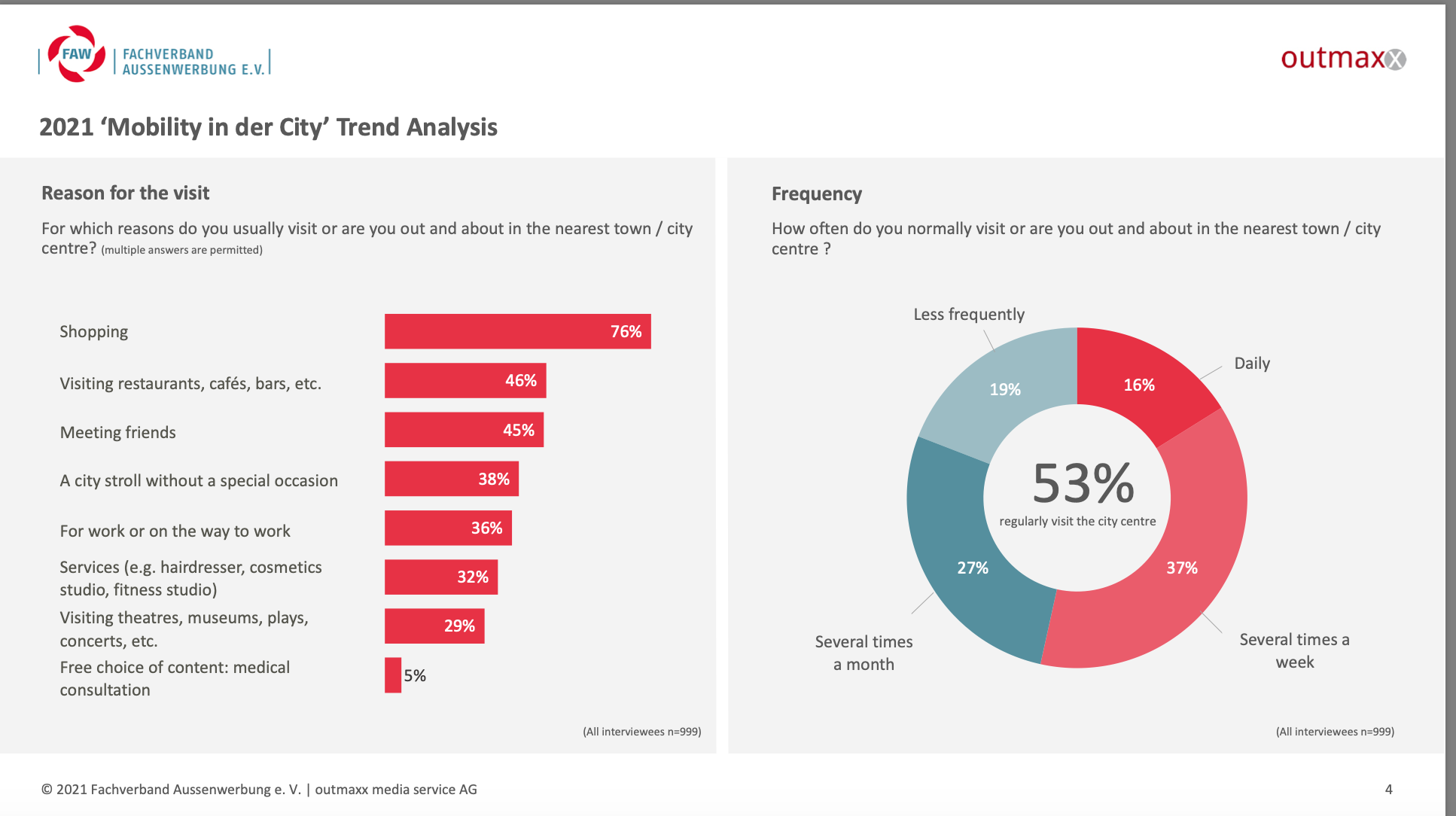
2021 ‘Mobility in the City’ Trend Analysis: with the end of the ‘Corona’ restrictions, the population wants to resume its usual mobility behaviour. The city centres will, once more, become the centre of “out of home” life.
After ‘Corona’ is before ‘Corona’, at least as far as the mobility of the population in the city centres is concerned: people are dying to get back into the centres of public life. Retail trade, gastronomy and service providers remain elementary attractions, while art and culture, leisure and recreation also continue to play an important role. However, we should not underestimate social life: for more than half of the population, meeting friends is a reason to visit the city centre. The bottom line is: as soon as the current restrictions on movement and contact are lifted, life in the heart of the cities will resume its dynamic pace – of course, in compliance with any regulations that may still exist.
80 per cent of the population regularly visit the city centre
This is the result of the current 2021 ‘Mobility in the City’ Trend Analysis, with which the Fachverband Aussenwerbung (FAW) and the agency outmaxx media continue their survey regarding the development of ‘out of home’ public life. As a matter of fact, this has been highly topical even before ‘Corona’: the German Retail
Association as well as institutions of urban promotion and, of course, the outdoor advertising industry have been concerned with the question of how people’s mobility in cities is likely to develop. Due to the restrictions that have been accompanying the fight against the pandemic for months, this question has gained even more weight.
The results of the trend analysis now available provide first-hand answers. In the online survey conducted in mid-January, a representative selection of the adult population provided information about their mobility behaviour before and after ‘Corona’. Their information confirms the high proportion that city centres have in out-of- home life. The housing situation demonstrates this quite clearly: almost half of the people live directly in the city (among the younger ones between the ages of 18 and 35 it is even 60 per cent), another quarter lives in the catchment area. As a result, more than 80 per cent are normally out and about in the city centres, i.e. at least several times a month, while 53 per cent are out several times a week or even daily.
Deliberate support for local businesses after the lockdown
Shopping ranks highest on the list of reasons for visiting the city centre: 76 per cent of those surveyed usually go there for this reason. Not everyone (51 percent) ‘missed’ this during the lockdown, the online shopping alternative is obviously making itself felt here. However, a significantly higher percentage (67 per cent), stated that they were likely to resume their old habits after the lockdown.
People consider the closure of the gastronomic outlets as even more painful than the limited local shopping opportunities: almost 60 per cent miss going to restaurants, cafés or even bars, and here, too, their will to return to this habit is clear. Moreover, 74 per cent of the interviewees confirm that they will consciously visit and support the local businesses (retailers, gastronomy and service providers, such as hairdressers, etc.) once the lockdown measures are over. Incidentally, this also applies to the younger target groups, despite a certainly higher affinity for online
shopping and delivery services. In this segment, it is still a proud 70 per cent who want to actively support the preservation of local businesses through their consumer behaviour as soon as this is possible again.
Quiet, recreational areas and better public transportation make cities attractive
The cities themselves can also contribute to maintaining their attractiveness as centres of public life and improving it for the benefit of the population. For example, more than half of the citizens would like to see an expansion of green areas, parks and recreational areas in the city (55 per cent), and almost as many would like to see more pedestrian or low-traffic zones. Many (41 per cent) would also like to see an improvement in public transportation links between the surrounding areas and the city, while for younger people, in particular, services, such as night buses, play an important role so that they can continue to travel around the city regularly.
FAW and outmaxx have summarised the results of the different aspects of the 2021 ‘Mobility in the City’ Trend Analysis in the attached presentation.
For further information please contact:
Karin Winter
Fachverband Aussenwerbung e.V., Frankfurt Tel 069 719167-40
winter@faw-ev.de
Subscribe to our weekly OOH newsletter
LATEST INDUSTRY NEWS: focusing on the top OOH stories of the week from around the world.










